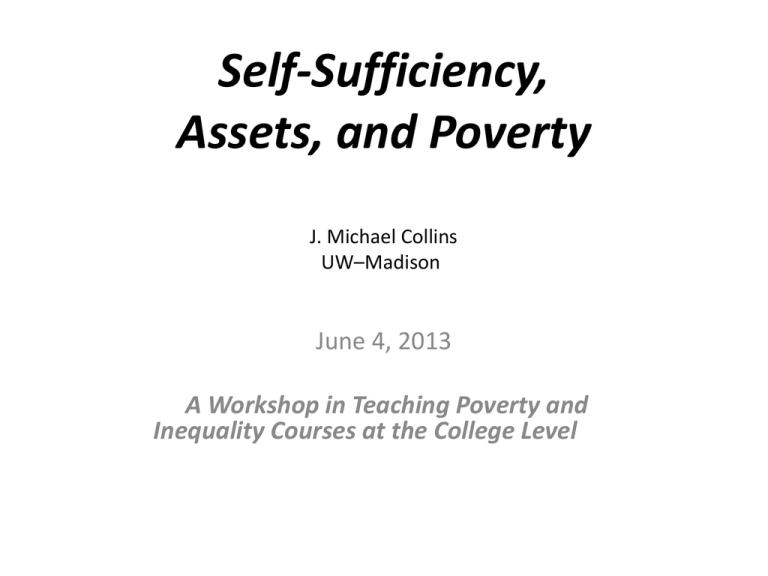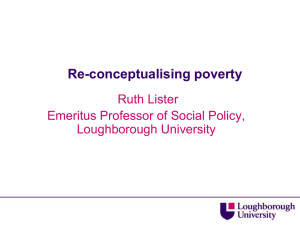Poverty 101 (ppt), Madison WI June 4, 2013
advertisement

Self-Sufficiency, Assets, and Poverty J. Michael Collins UW–Madison June 4, 2013 A Workshop in Teaching Poverty and Inequality Courses at the College Level Self-Sufficiency, Assets, and Poverty Broad But Interrelated Topics: 1. Self-Sufficiency 2. Financial Capability 3. Asset Building & Savings Goals • Introduce topic and connect to poverty in US – Overview of some key issues (among many) • Suggested poverty course topics – Outline of content for course sessions • 5-6 fundamental pieces for a reading list • Start a discussion Self-Sufficiency • Accessing benefits – Eligibility and take up • Stable housing – And related services • Movement into work – Child care – Relax work ‘penalty’ – Also movement off of public assistance • Managing resources more efficiently – Budgeting, Spending • Dealing with legal issues – Judgments – Garnishment – Child Support Financial Capability • Financial Knowledge – Literacy – Numeracy • Financial Access – Financial Inclusion – Underbanked – Products: transactions & savings • Financial Skills – Planning – Goals & Intentions • Dealing with negative triggers – Emergency expenses – Borrowing • Attitudes – Stress – Confidence – Trust Asset Building • Savings – Restricted purpose • Small business • Homeownership • Education • Risk-taking – Leverage assets with debt • Political / Social Stake – Ownership in community • Future Orientation – Aspirations for children Asset Poverty • Wealth holdings are not sufficient to secure the socially determined minimum standard of living for a given period of time (Brandolini, Magri, & Smeeding, 2010, p. 271). • Common threshold is whether a household has sufficient assets to sustain at the national poverty level for three months without any income (Haveman & Wolff, 2005). – Assets = household net worth, or total ‘marketable assets’ - total debt • 19.6% of households “Asset Poor” in 2010 (Ratcliffe & Zhang, 2012). – Liquid asset poverty = lack of cash or other sources that can be monetized quickly (bank accounts, bonds or CDs, stocks, mutual funds, retirement accounts) – $5,763 liquid asset poverty threshold (family of four) – Survey of Income and Program Participation (SIPP) data indicate that in the US liquid asset poverty increased from 41.4% in 2006 to 43.9% in 2010. – Liquid asset poverty is highest for female headed and minority households; 80% for households below 200% of the federal poverty level (Aratani & Chau, 2010). • Asset poverty is distinct: Rates of asset poverty remained steady even as income poverty declined (Caner & Wolff, 2004). Aratani, Yumiko, and Michelle M. Chau. "Asset poverty and debt among families with children." (2010). http://academiccommons.columbia.edu/catalog/ac:126218 Aratani, Yumiko, and Michelle M. Chau. "Asset poverty and debt among families with children." (2010). http://academiccommons.columbia.edu/catalog/ac:126218 Aratani, Yumiko, and Michelle M. Chau. "Asset poverty and debt among families with children." (2010). http://academiccommons.columbia.edu/catalog/ac:126218 Shapiro, Thomas M., Tatjana Meschede, and Laura Sullivan “Wealth gap increases fourfold.” Research and Policy Brief, The Heller School for Social Policy and Management, Brandeis University (May 2010). Pew Charitable Trusts. “Pursuing the American dream: Economic mobility across generations.” Pew Charitable Trusts, Economic Mobility Project. (July 2010). http://www.pewstates.org/research/reports/pursuing-the-american-dream-85899403228 Mills, Gregory, and Joe Amick. "Can Savings Help Overcome Income Instability?." Washington, DC: The Urban Institute (2010). http://www.urban.org/publications/412290.html Coping with an Emergency Lusardi, Annamaria, Daniel J. Schneider, and Peter Tufano. Financially fragile households: Evidence and implications. No. w17072. National Bureau of Economic Research, 2011. 2. Financial Capability State by State Data • http://www.usfinancialcapability.org/ Unbanked FDIC (2012). http://www.fdic.gov/householdsurvey/2012_unbankedreport.pdf Aratani, Yumiko, and Michelle M. Chau. "Asset poverty and debt among families with children." (2010). http://academiccommons.columbia.edu/catalog/ac:126218 Un & Under-banked FDIC (2012). http://www.fdic.gov/householdsurvey/2012_unbankedreport.pdf FDIC (2012). http://www.fdic.gov/householdsurvey/2012_unbankedreport.pdf Abbi, Sarika. “A need for product innovation to help LMI consumers manage financial emergencies..” D2D Fund: Doorways to Dreams. (2012). Compared to What? Eliminate access to liquidity…what happens next? - bounced checks - missed payments What do you note about window signs? How Households Handle Shortfall: Abbi, Sarika. “A need for product innovation to help LMI consumers manage financial emergencies..” D2D Fund: Doorways to Dreams. (2012). Mills, Gregory, and Joe Amick. "Can Savings Help Overcome Income Instability?." Washington, DC: The Urban Institute (2010). http://www.urban.org/publications/412290.html Debt Klawitter, M., & Collin Morgan-Cross . “Assets, credit use and debt among low-income households.” (2012). http://depts.washington.edu/wcpc/sites/default/files/papers/Credit%20andDebt%205_23_12.pdf Debt Holding by Type Klawitter, M., & Collin Morgan-Cross . “Assets, credit use and debt among low-income households.” (2012). http://depts.washington.edu/wcpc/sites/default/files/papers/Credit%20andDebt%205_23_12.pdf Debt to Make Ends Meet • Demand for alternative credit driven by: – – – – Bills due before the next paycheck Unexpected expenses Expenses that exceeded income Drop in income • Most common uses of alternative credit: – Pay basic living expenses – Pay or utility/housing bills – Home or car-related repairs and purchases FDIC. “2011 FDIC National Survey of Unbanked and Underbanked Households.”Federal Deposit Insurance Corporation. (2012); Levy, Robert, and Josh Sledge. “A complex portrait: An examination of small-dollar credit consumers.” Center for Financial Services Innovation, (2012). Debt: Alternative Financial Services Klawitter, M., & Collin Morgan-Cross . “Assets, credit use and debt among low-income households.” (2012). http://depts.washington.edu/wcpc/sites/default/files/papers/Credit%20andDebt%205_23_12.pdf Financial Literacy • Jump$tart – High school tests – 31 multiple choice questions. Average score = 47% correct. • Financial Literacy Measures - Lusardi and Mitchell 1. Suppose you had $100 in a savings account and the interest rate was 2% per year. After 5 years, how much do you think you would have in the account if you left the money to grow: more than $102, exactly $102, or less than $102? 2. Imagine that the interest rate on your savings account was 1% per year and inflation was 2% per year. After 1 year, would you be able to buy more than, exactly the same as, or less than today with the money in this account? 3. Do you think that the following statement is true or false? “Buying a single company stock usually provides a safer return than a stock mutual fund.” Lusardi, Annamaria, and Olivia S. Mitchell. "Baby boomer retirement security: The roles of planning, financial literacy, and housing wealth." Journal of monetary Economics 54.1 (2007): 205-224. Financial Decisions that Matter for Low-Income Families • Schooling: Human Capital Investments • Debt Management: Default, Judgments, Bankruptcy, Tax delinquency • Income Tax filing: EITC claiming and use of Refund • Managing program rules; Enroll, qualify, retain • Avoiding Scams • Use of Social Security and Disability – Claiming too early – Using DI when no alternative jobs Studies of Financial Education • Array of methodological weaknesses – Selection bias due to non-randomized designs – Self-reported measures – Behavior vs. knowledge – Heterogeneous ‘treatment’ (content and mode) Weak Evidence for Financial Education Collins, J. Michael, and C M. O’Rourke. "Financial education and counseling—Still holding promise." Journal of Consumer Affairs 44.3 (2010): 483-498. Education = More Debt? Collins, J. Michael. "The Impacts of Mandatory Financial Education: Evidence from a Randomized Field Study." Journal of Economic Behavior & Organization,(2012). Asset Building • Idea came from Michael Sherraden: Assets and the Poor: A New American Welfare Policy in 1991 • Private foundations provided funds to test idea • Assets for Independent Act passed in 1998 with broad bipartisan support INDIVIDUAL DEVELOPMENT ACCOUNTS Match amount -- 2:1 is typical IDAs should be designed to SAVINGS MOBILIZATION Deliberate and consistent savings over time improve access to savings institutions FINANCIAL EDUCATION for the poor, Boosting consumer knowledge address public Building personal financial management policy mechanisms skills that subsidize Application savings, and grow INCENTIVES/ACCRUED MATCH wealth among the Match support to close the income gap poor through asset ASSET PURCHASE accumulation A blend of savings and match are directed toward a high return asset FACILITATION The mechanism for continued savings Center for Social Development Washington University IDA Impacts Social Experiment: 10 years of studies • IDA participation is associated with: Increased employment Better budgeting and financial planning Increased homeownership rates of renters • But NOT: Reduced receipt of public assistance benefits No evidence that IDA participation increases net worth in the first 3 to 4 years. 40% withdrew the entire balance for non-qualifying purposes Willing to forfeit the match in order to access funds • Program costs to dollars saved: $1 of net savings costs $3. Child Development Accounts • SEED Accounts • Matched accounts for children – about half are 529 plans • Withdrawals for postsecondary education, vehicles, computers, health – $1,518 saved after 5 years • SEED for Oklahoma Kids experiment (RCT) – 2008: 1,360 kids given $1000 529 accounts at birth Overall • Seems Assets are an important consideration – Barriers to saving – Use for savings in emergency or for contingency • Less clear how to promote savings – Education weak at best – Direct subsidy (pay to save) not cost effective so far • Policy and practice implications… – Further experiments – Need for evidence – Caution about ‘right’ behavior or outcome Course Topics • Asset vs. Income Poverty – Distinctions and importance • Financial services and unbanked – Alternative financial services • Financial Literacy – Behavior & knowledge (behavioral economics) • Financial Capability and Self Sufficiency – Cases from public programs Potential Extensions • Asset tests in public programs • Predatory lending, auto title pawn and payday loan restrictions • EITC refund and savings at tax time • Retirement savings and employer options relative to Social Security annuity value • Homeownership and mortgage access • Medical debt and bankruptcy • Financial security and domestic violence • Behavioral economics and decision-making of people in poverty Prisoner Re-entry Former offenders have few financial resources but many needs/obligations - Needs/Obligations: - Financial liquidity need at moment of re-entry - Civilian clothing, food, transportation, basic toiletries, housing - Court costs/restitution - Supervision fees - Child support arrears problems - How to address these financial problems? - Education? Financial Access? Idaho: $1,500 for lodging and living expenses for first 30 days post-release to offenders at risk of homelessness Oregon: Oregon Trail Card allows offenders to access funds in their prison trust account, food stamps, and other public benefits immediately upon release Case Study: Prisoner Re-entry Former offenders have few financial resources but many needs/obligations - Resources: - ‘Gate money’ issued via check $54 mean amount (30% of states provide $0) - Access to any prison earned wages is often delayed by several weeks - 1 in 5 have employment arranged at time of release - Reliance on family/friends is common but relationships may be strained Key Readings 1. Blank, R. M., & Barr, M. S. (2009). Insufficient funds: Savings, assets, credit, and banking among low-income households. New York: Russell Sage Foundation Publications. Chapter 1 2. Lusardi, A., Schneider, D. J., & Tufano, P. (2011). Financially fragile households: Evidence and implications (No. w17072). National Bureau of Economic Research. 3. Bertrand, M., Mullainathan, S., & Shafir, E. (2006). Behavioral economics and marketing in aid of decision making among the poor. Journal of Public Policy and Marketing 25(1), 8-23. 4. Aratani, Y., & Chau, M. (2010). Asset Poverty and Debt Among Families with Children. New York: National Center for Children in Poverty. Accessible Readings • Aratani, Y., & Chau, M. (2010). Asset Poverty and Debt Among Families with Children. New York: National Center for Children in Poverty. • Bertrand, M., Mullainathan, S., & Shafir, E. (2006). Behavioral economics and marketing in aid of decision making among the poor. Journal of Public Policy and Marketing 25(1), 8-23. • Klawitter, M., & Morgan-Cross, C. (2012). Assets, Credit Use and Debt of LowIncome Households (May 11, 2012). Evans School of Public Affairs, University of Washington. http://depts.washington.edu/wcpc/sites/default/files/papers/Credit%20andDebt%205_23_12.pdf • Mills, G. B., & Amick, J. (2010). Can Savings Help Overcome Income Instability? Urban Institute, http://www.urban.org/publications/412290.html • O'Brien, R. (2012). We don't do banks: Financial Lives of Families on Public Assistance. Geo. J. Poverty Law & Policy 19, 485-535. • Shapiro, T. M., Meschede, T., & Sullivan, L. (2010). Wealth Gap Increases Fourfold. Research and Policy Brief, The Heller School for Social Policy and Management, Brandeis University. Books (* suggested chapters): • • Barr, M. S. (2012). No Slack: The Financial Lives of Low-income Americans. Brookings Institution Press. Blank, R. M., & Barr, M. S. (2009). Insufficient funds: Savings, assets, credit, and banking among low-income households. New York: Russell Sage Foundation Publications. – – – • • • Barr, M, & Blank, R. Savings, assets, credit, and banking among low-income households: Introduction and Overview. (pp. 1-23). Mullainathan, S., & Shafir, E. Savings policy and decision-making in low-income households. (pp. 121-142). Sherraden, M. Individual development accounts and asset-building policy: Lessons and directions. (pp. 191-217). Edin, K., & Lein, L. (1997). Making ends meet: How single mothers survive welfare and low-wage work. Russell Sage Foundation Publications. Schreiner, M., & Sherraden, M. (2007). Can the Poor Save? Saving and Asset Building in Individual Development Accounts. New Brunswick, NJ: Transaction Publishers. Shapiro, T. M., & Wolff, E. N. (2001). Assets for the Poor: the benefits of spreading asset ownership. New York Russell Sage Foundation Publications. – – Carney, S. & Gale, W. G. Asset accumulation among low-income households. (pp. 165-205). Edin, K. More than money: The role of assets in the survival strategies and material well-being of the poor. (pp. 206-231) Journal Articles: • • • • • • • • • • • • • • • Bertrand, Marianne, Sendhil Mullainathan, and Eldar Shafir. (2006). Behavioral economics and marketing in aid of decision making among the poor. Journal of Public Policy and Marketing 25(1): 8-23. Beverly, S. G., & Sherraden, M. (1999). Institutional determinants of saving: Implications for low-income households and public policy. Journal of Socio-economics, 28(4), 457-473. Brandolini, A., Magri, S., & Smeeding, T. M. (2010). Asset‐based measurement of poverty. Journal of Policy Analysis and Management, 29(2), 267-284. Carter, M. R. & C. Barrett (2006). The economics of poverty traps and persistent poverty: An asset-based approach. The Journal of Development Studies, 42 (2), 178-199. Collins, J. Michael, and Collin M. O’Rourke. Financial education and counseling—Still holding promise. Journal of Consumer Affairs 44.3 (2010): 483-498. Haveman, R., & Wolff, E. N. (2005). The concept and measurement of asset poverty: Levels, trends and composition for the US, 1983– 2001. Journal of Economic Inequality, 2(2), 145-169. Hogarth, J. M., & Anguelov, C. E. (2003). Can the poor save? Financial Counseling and Planning, 14(1), 1-18. Hurst, E., & Ziliak, J. P. (2006). Do Welfare Asset Limits Affect Household Saving? Evidence from Welfare Reform. Journal of Human Resources, 41(1), 46–71. Lerman, Robert I. and Eugene Steuerle, Life-Cycle Investing: Financial Education and Consumer Protection (and response), Research Foundation Publications (November 2012): 85-96. http://www.cfapubs.org Lusardi, A., Schneider, D. J., & Tufano, P. (2011). Financially fragile households: Evidence and implications (No. w17072). National Bureau of Economic Research. Mills, G., Gale, W. G., Patterson, R., Engelhardt, G. V., Eriksen, M. D., & Apostolov, E. (2008). Effects of individual development accounts on asset purchases and saving behavior: Evidence from a controlled experiment. Journal of Public Economics, 92(5), 1509-1530. O'Brien, R. (2009). Ineligible to Save? Asset Limits and the Saving Behavior of Welfare Recipients. Journal of Community Practice, 16(2), 183-199. O'Brien, Rourke. "POLICY & PRACTICE:" We don't do banks": Financial Lives of Families on Public Assistance." Geo. J. Poverty Law & Policy 19 (2012): 485-535. Sullivan, J. X. (2006). Welfare Reform, Saving, and Vehicle Ownership Do Asset Limits and Vehicle Exemptions Matter?. Journal of Human Resources, 41(1), 72-105. Zinman, J. (2010). Restricting consumer credit access: Household survey evidence on effects around the Oregon rate cap. Journal of Banking & Finance, 34(3), 546-556. Briefs • • • • • • Abbi, S. (2012). A need for product innovation to help LMI consumers manage financial emergencies. D2D Fund: Doorways to Dreams. Aratani, Y. &, Chau, M. (2010 ) Asset Poverty and Debt Among Families with Children, February. http://academiccommons.columbia.edu/catalog/ac:126218 Beverly, S., Sherraden, M., Cramer, R., Shanks, T. R. W., Nam, Y., & Zhan, M. (2008). Determinants of asset building: A Report in the Series – Poor Finances: Assets and LowIncome Households. The Urban Institute, Center for Social Development, and the New America Foundation. McKernan, S. M., Ratcliffe, C., & Vinopal, K. (2009). Do Assets Help Families Cope with Adverse Events?. Washington, DC: Urban Institute. Mills, G. & Amick, J. (December 2010). Can savings help overcome income instability? The Urban Institute: Perspectives on Low-Income Working Families, Brief 18. http://www.urban.org/publications/412290.html Ratcliffe, C., & Zhang, S. (2012). US Asset Poverty and the Great Recession. Urban Institute. • Shapiro, T. M., Meschede, T., & Sullivan, L. (2010). Wealth Gap Increases Fourfold. Research and Policy Brief, The Heller School for Social Policy and Management, Brandeis University. J. Michael Collins Faculty Director, Center for Financial Security University of Wisconsin-Madison Madison, WI 53706 (608) 616-0369 jmcollins@wisc.edu For More Information: cfs.wisc.edu For More Information: cfs@mailplus.wisc.edu Follow us on and UWMadisonCFS








